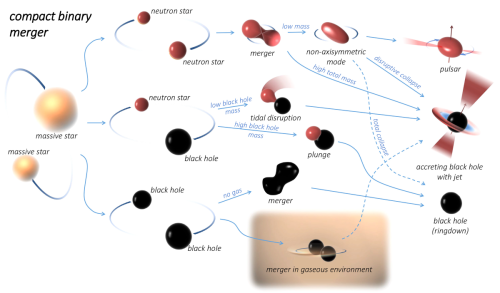
Brave new worlds: what LIGO–Virgo could see. Click on image to expand. (Courtesy: I Bartos and M Kowalski)
By Hamish Johnston
I think it’s safe to say that most Nobel-watchers were predicting a LIGO-related physics prize this year, and for very good reasons.
For millennia, humans could only see visible light from the cosmos. It was only during the previous century that we have been able to view the universe across much more of the electromagnetic spectrum – as well as through the arrival of high-energy particles such as cosmic rays and neutrinos.
But until very recently there had been a gaping hole in our knowledge, which is now being filled by the LIGO and Virgo gravitational observatories.
Before LIGO detected its first signal in 2015 – gravitational waves from the merger of two black holes – we weren’t sure that black holes with masses of several tens of suns even existed. Just two years (and three more black-hole mergers) later we are beginning to understand how such black holes are formed.
The era of gravitational astronomy is well under way, but that is not the end of the story. With three gravitational-wave detectors spread out over two continents (and more on the way), astronomers can now point an array of telescopes at the sources of gravitational waves to capture electromagnetic radiation. Particle physicists can also monitor underground detectors to look for related pulses of high-energy cosmic neutrinos.
Dubbed multimessenger astronomy, this new way of seeing the heavens could reveal astronomical events that had been beyond the view – and even beyond the imagination – of astrophysicists.
You can find a fantastic introduction to this emerging discipline in Multimessenger Astronomy, which is a Physics World Discovery ebook by Imre Bartos of the University of Florida and Marek Kowalski of Humboldt University and DESY. It is free to read, so dive in and enjoy.
Guidelines
Show/hide formatting guidelines
this text was deletedwhere people live in harmony with nature and animals</q>
Some text